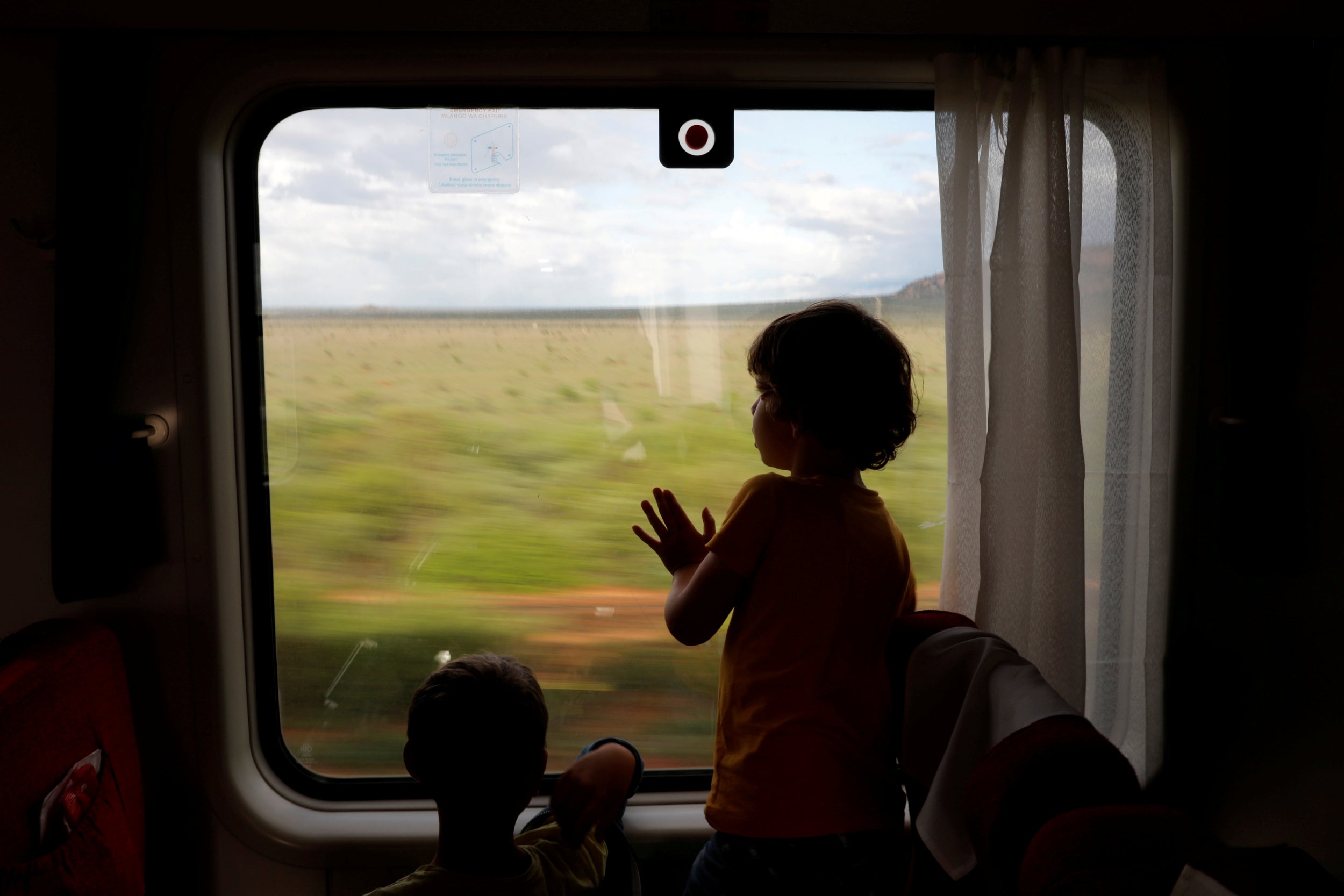Government supporters celebrate defeat of rebels in Aleppo, while humanitarian disaster unfolds on other side of battle lines, writes Richard Hall

Left: In the west of Syria's northern province of Aleppo on 16 February, people flee advancing Syrian government forces. Right: Meanwhile, crowds gather to celebrate at the Saadallah al-Jabiri square in Aleppo ( AFP )
It was the kind of split-screen moment that has come to define the Syrian war.
Over the past week, thousands of desperate families have been fleeing airstrikes and shelling in western Aleppo, many of them leaving their homes for the third or fourth time in a seemingly futile search for safety.
At the same time, inside the city itself, crowds of government supporters took to the streets to celebrate the rout of rebel forces on its outskirts, and the Syrian army claimed a symbolic and strategic victory in the long-running battle for Aleppo.
Backed by intensive airstrikes from Russian and Syrian jets, government troops captured more than 30 villages in the western countryside of Aleppo over the weekend. In doing so, they put the country’s second city out of reach of rebel fire for the first time in years and cemented control of the former commercial hub’s link to the capital, Damascus.
In a televised address on Monday, President Bashar al-Assad promised to push on further with the offensive.
“This liberation does not mean the end of the war, and does not mean the end of the schemes nor the end of terrorism or the surrender of enemies,” he said.
“But it means that we rubbed their noses in the dirt as a prelude for complete victory and ahead of their defeat, sooner or later.”
Syrian regime bombards Idlib
Show all 23




Syrian state news reported that the city had been rescued “from terrorism and shells of hatred and spite from which the city has been suffering for many years.”
But what was a liberation for some was little short of Armageddon for others.
Some 900,000 people have been displaced since early December by the offensive in western Aleppo and neighbouring Idlib province – the largest single displacement of the entire war.
The vast majority of those fleeing are women and children. With no shelter available for the new arrivals, many are being forced to sleep in the open air in freezing temperatures. As many as seven children – including one baby only seven months old – have died from the cold and horrific living conditions in camps, according to Save the Children.
Read more

Masses of civilians flee regime bombs in Syria’s Idlib
Many of those who fled from western Aleppo in recent weeks were uprooted from the city itself in 2016, when rebel forces surrendered in east Aleppo after years of bloody fighting.
Ahmed Aziz, a 29-year-old charity worker, was one of them. After living in the western suburbs of Aleppo since then, he left a few weeks ago with his family for the city of Azaz, near the Turkish border, when the fighting came too close.
“I didn’t go away from my city. I lived in the countryside and it was so close, I could see the western parts of the city. I dreamed of returning,” he tells The Independent by phone.
That dream has now faded, he says.
“For those Assad supporters in my city, I find it brutal that they dance on our bodies. Those who have been killed by the government are human beings. They are people who wanted to live in a free country,” he says.

Civilians flee from Idlib to find safety inside Syria near the border with Turkey, 11 February 2020 (AP)
The battle for the ancient city of Aleppo was one of the most consequential of the entire war.
The capture of the eastern parts of the city by rebels in 2012, after the government violently cracked down on peaceful protests against Mr Assad’s rule, marked one of the opposition’s biggest early successes, even as it failed to breach the west of the city.
Despite a devastating and indiscriminate air campaign by government jets, rebel forces held out in east Aleppo for years. That changed in 2015, when Russia entered the war on the government’s side.
By 2016, with Moscow’s help, Syrian government forces besieged east Aleppo. While rebel forces were also responsible for indiscriminate shelling of the city’s western half, intensive Russian and Syrian government airstrikes targetted hospitals and civilian infrastructure in the east on a much larger scale, squeezing rebels and civilians alike until they surrendered in December 2016.
The biggest humanitarian horror story of the 21st Century will only be avoided if Security Council members, and those with influence, overcome individual interests and put a collective stake in humanity first. The only option is a ceasefire.Mark Lowcock, United Nations under-secretary-general for humanitarian affairs
An array of rebel groups, jihadist militias among them, left the city for western Aleppo and Idlib province, as did thousands of civilians. The loss of Aleppo was a crushing blow for rebel forces, from which they never fully recovered.
Today, again backed by Russian airstrikes, Mr Assad’s forces are pushing further into the last rebel-held bastion of Idlib and western Aleppo, which is controlled by both nationalist and jihadist groups who have united to fight off the attack, among them the extremist Hayyat Tahrir al-Sham.
Russian and Syrian bombing has killed close to 300 civilians since 1 January, the United Nations said on Tuesday, 93 per cent of which were caused by the Syrian government and its allies. Civilians are fleeing for the Turkish border and overwhelming relief agencies. Drone footage of a displacement camp in Northern Idlib, Syria.
“Civilians fleeing the fighting are being squeezed into areas without safe shelter that are shrinking in size by the hour. And still they are bombed. They simply have nowhere to go,” UN human rights chief Michelle Bachelet said in a statement.
On Monday, the UN’s under-secretary-general for humanitarian affairs, Mark Lowcock, warned of “the biggest humanitarian horror story of the 21st century” if a ceasefire is not reached.
The UN has called on Russia and Turkey, which backs a number of rebel groups and has its own forces stationed in Idlib, to agree to broker another ceasefire to allow humanitarian groups to assist those in need.
On Tuesday, a Turkish delegation ended two days of talks with Russian officials in Moscow with no statements made.
Turkey has kept its border closed to Syrians fleeing the fighting, fearing another wave of refugees to add to the 3.5 million already in the country.
That has left those displaced from the recent fighting, like Mr Aziz, with nowhere to go.
Many of those who fled from western Aleppo in recent weeks were uprooted from the city itself in 2016, when rebel forces surrendered in east Aleppo after years of bloody fighting.
Ahmed Aziz, a 29-year-old charity worker, was one of them. After living in the western suburbs of Aleppo since then, he left a few weeks ago with his family for the city of Azaz, near the Turkish border, when the fighting came too close.
“I didn’t go away from my city. I lived in the countryside and it was so close, I could see the western parts of the city. I dreamed of returning,” he tells The Independent by phone.
That dream has now faded, he says.
“For those Assad supporters in my city, I find it brutal that they dance on our bodies. Those who have been killed by the government are human beings. They are people who wanted to live in a free country,” he says.

Civilians flee from Idlib to find safety inside Syria near the border with Turkey, 11 February 2020 (AP)
The battle for the ancient city of Aleppo was one of the most consequential of the entire war.
The capture of the eastern parts of the city by rebels in 2012, after the government violently cracked down on peaceful protests against Mr Assad’s rule, marked one of the opposition’s biggest early successes, even as it failed to breach the west of the city.
Despite a devastating and indiscriminate air campaign by government jets, rebel forces held out in east Aleppo for years. That changed in 2015, when Russia entered the war on the government’s side.
By 2016, with Moscow’s help, Syrian government forces besieged east Aleppo. While rebel forces were also responsible for indiscriminate shelling of the city’s western half, intensive Russian and Syrian government airstrikes targetted hospitals and civilian infrastructure in the east on a much larger scale, squeezing rebels and civilians alike until they surrendered in December 2016.
The biggest humanitarian horror story of the 21st Century will only be avoided if Security Council members, and those with influence, overcome individual interests and put a collective stake in humanity first. The only option is a ceasefire.Mark Lowcock, United Nations under-secretary-general for humanitarian affairs
An array of rebel groups, jihadist militias among them, left the city for western Aleppo and Idlib province, as did thousands of civilians. The loss of Aleppo was a crushing blow for rebel forces, from which they never fully recovered.
Today, again backed by Russian airstrikes, Mr Assad’s forces are pushing further into the last rebel-held bastion of Idlib and western Aleppo, which is controlled by both nationalist and jihadist groups who have united to fight off the attack, among them the extremist Hayyat Tahrir al-Sham.
Russian and Syrian bombing has killed close to 300 civilians since 1 January, the United Nations said on Tuesday, 93 per cent of which were caused by the Syrian government and its allies. Civilians are fleeing for the Turkish border and overwhelming relief agencies. Drone footage of a displacement camp in Northern Idlib, Syria.
“Civilians fleeing the fighting are being squeezed into areas without safe shelter that are shrinking in size by the hour. And still they are bombed. They simply have nowhere to go,” UN human rights chief Michelle Bachelet said in a statement.
On Monday, the UN’s under-secretary-general for humanitarian affairs, Mark Lowcock, warned of “the biggest humanitarian horror story of the 21st century” if a ceasefire is not reached.
The UN has called on Russia and Turkey, which backs a number of rebel groups and has its own forces stationed in Idlib, to agree to broker another ceasefire to allow humanitarian groups to assist those in need.
On Tuesday, a Turkish delegation ended two days of talks with Russian officials in Moscow with no statements made.
Turkey has kept its border closed to Syrians fleeing the fighting, fearing another wave of refugees to add to the 3.5 million already in the country.
That has left those displaced from the recent fighting, like Mr Aziz, with nowhere to go.















